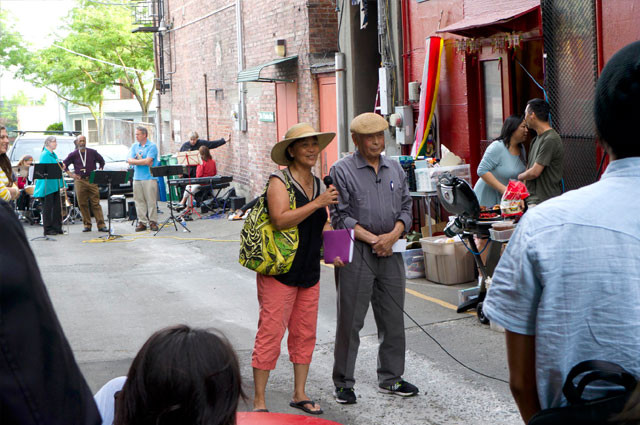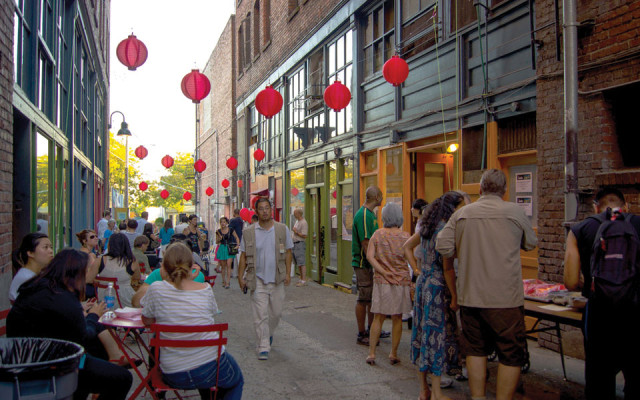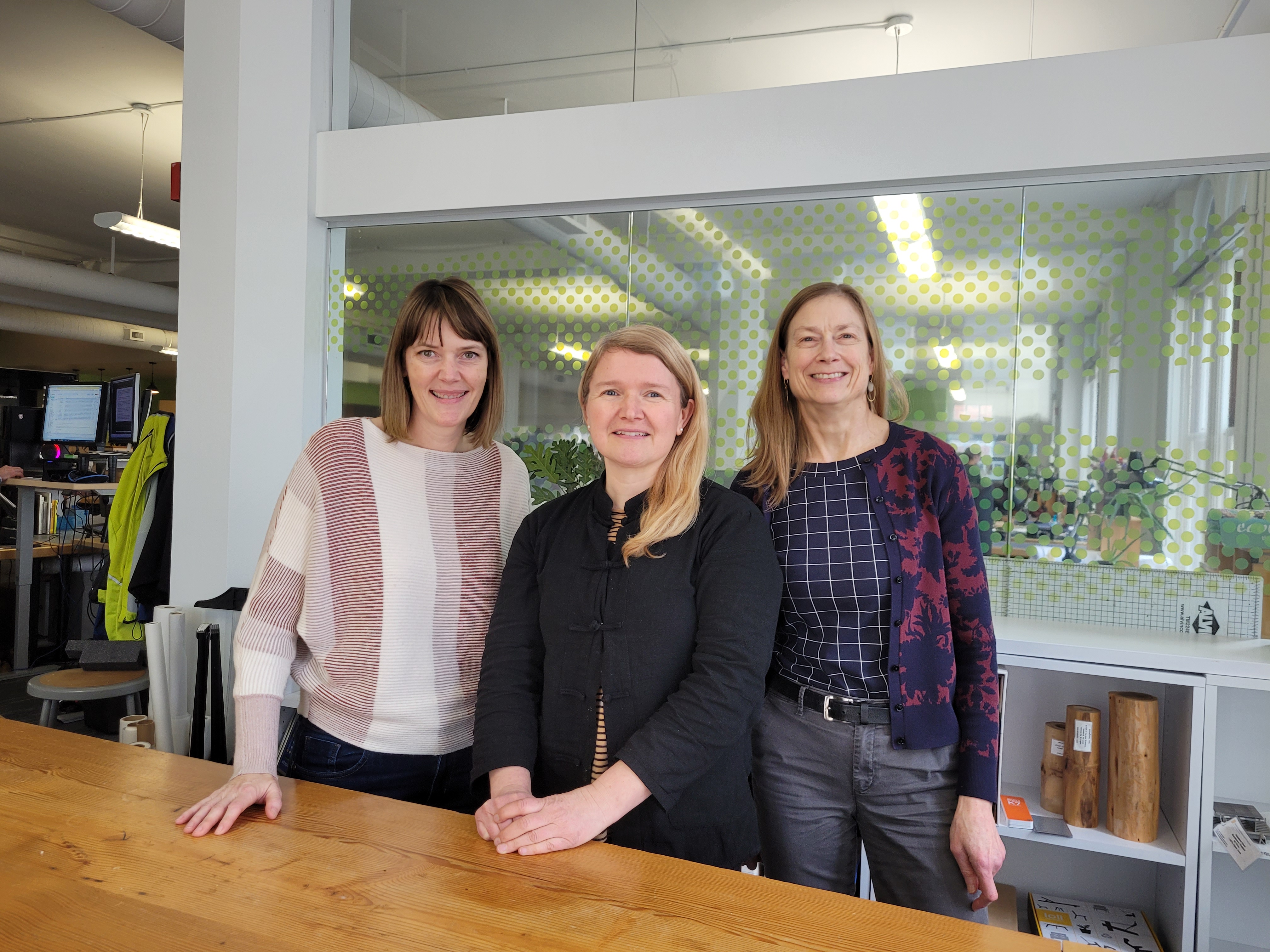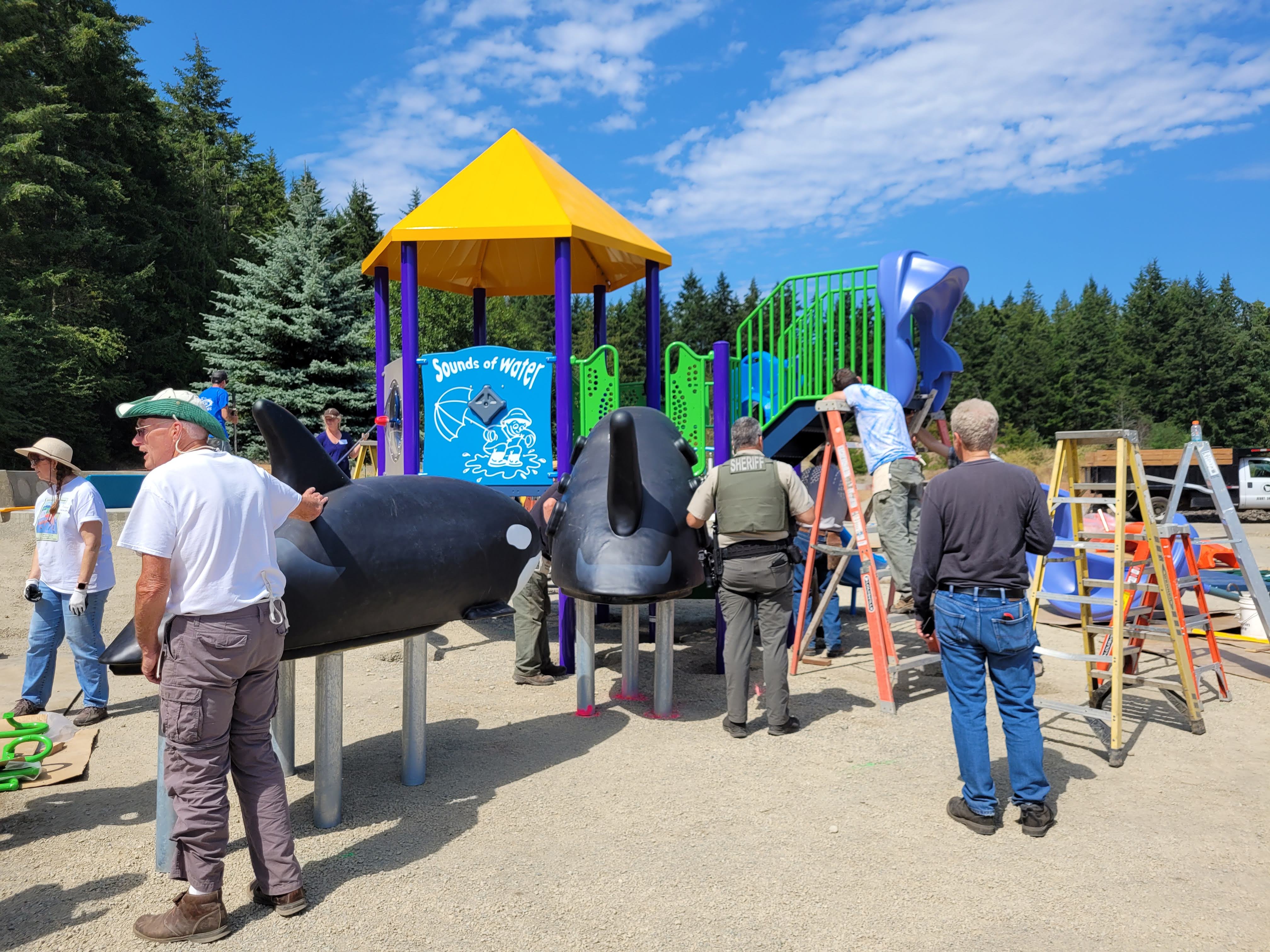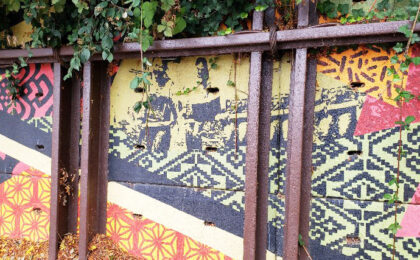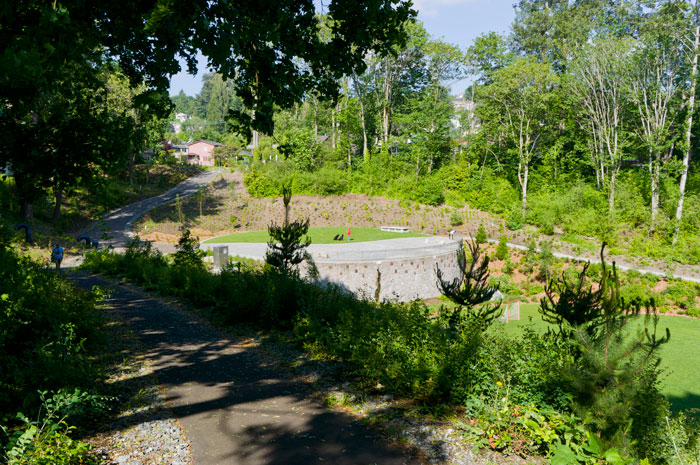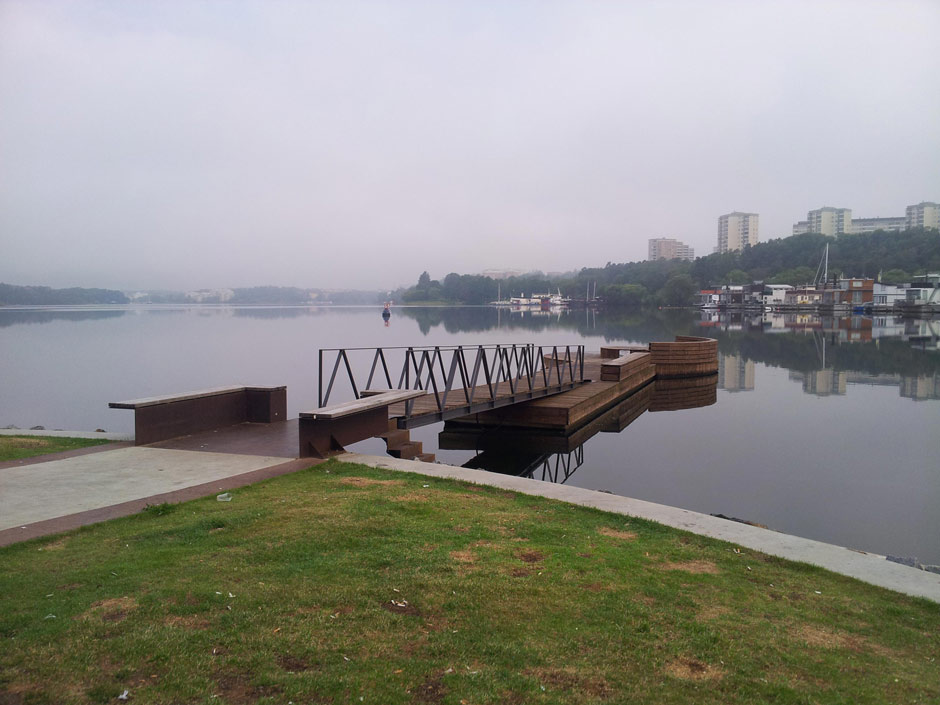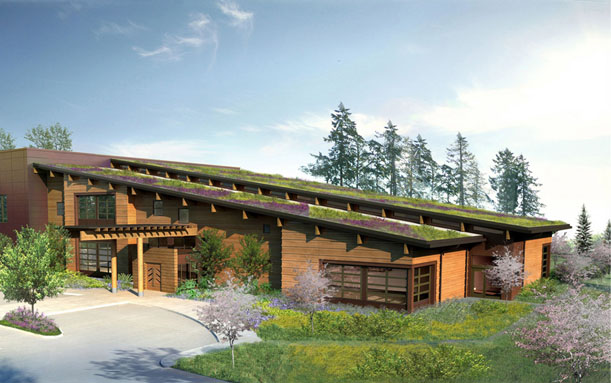SCIDpda: Leading Community-Based Change in Seattle’s Chinatown-International District
July 8, 2015 | By Admin |
SCIDpda (Seattle Chinatown International District Preservation and Development Authority), through their program, IDEA Space, engages and empowers members of the Chinatown International District to collaboratively implement strategies for neighborhood revitalization. It is a truly inspiring organization and a leader in the arena of community development in the region and even the nation.
Ching Chan is the Design Lab Coordinator at IDEA Space. She manages physical improvement projects in the neighborhood such as the Canton Alley revitalization project and the redevelopment of Hing Hay Park. A recent event in Canton Alley called “Stories in the Alley” featured Uncle Bob Santos and his new book, Gang of Four, a history of the Civil Rights Movement in Seattle.
Ching answered some of questions we had to shed light on the importance of this work and the role of community organizations.
Nakano Associates: There are a lot of physical changes going on in the Chinatown International District (CID) from the Hing Hay Park expansion to the renovation of historic buildings. What is the role SCIDpda is playing? Maybe the better question is, are there projects you aren’t involved in?
Ching Chan: SCIDpda is involved in most of the capital improvement projects and changes to the built environment in the Chinatown International District. Depending on the nature of the project, our role shifts between project management, consultant, advocate, and community liaison. There are few projects that we’re not involved in. At the minimum, we reach out to community members to inform them about projects happening in and around the neighborhood and educate them about the processes and how these projects may impact their quality of life. IDEA Space also holds quarterly open houses to highlight these projects and/or City policy changes and engage community stakeholders in these conversations.
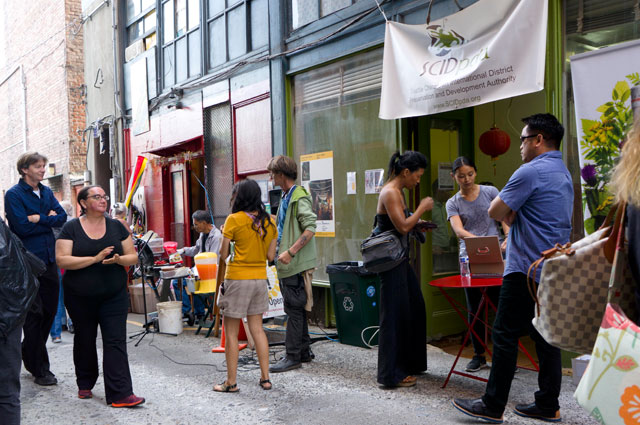
Food, drinks, and activities at Stories in the Alley
NA: Why is the revitalization of Canton Alley important to SCIDpda?
CC: The revitalization of Canton Alley is important to SCIDpda because it is the PDA’s mission to preserve, promote and develop the Seattle Chinatown International District as a vibrant community and unique ethnic neighborhood. It is critical to preserve and embrace the history and culture of our alleys as they contribute to the unique character of this neighborhood. Through physical improvements, we’re also able to re-introduce businesses back into the vacant storefronts, attract more pedestrians and bring life back into these spaces.
Canton Alley used to be a hub of retail and community activities. The alley storefronts once housed small shops, the Sing Lee Carpenter Shop being one of the most well-known stores in the community at the time. Shop owners lived in the back of their storefronts while other families live in the apartment spaces above. Because the apartment spaces were small and limited (and most families had more than one child), a lot of their daily activities spilled out into the alley. The alley then became play space for children and space for local residents and business owners to gather and socialize. At one point, there was also a small community garden off of the alley (where the Chong Wa parking lot is now located) where nearby residents would grow vegetables native to their homes. Some even used the alley as a space to dry their vegetables and sell their produce. We want to bring that tight-knit sense of community back into Canton Alley.
NA: What is your favorite thing about the Alley Parties such as Stories in the Alley? What role do they play in the project?
CC: My favorite thing about our Alley Parties and JamFests (hosted by Wing Luke Museum) is simply seeing people using the alley as a public space. Because we have a small budget, we often employ our creativity to make the space an interesting and fun space for pedestrians. These events are critical in getting the community excited about the alley revitalization project and more importantly, allowing people to experience the space and discover its potential.
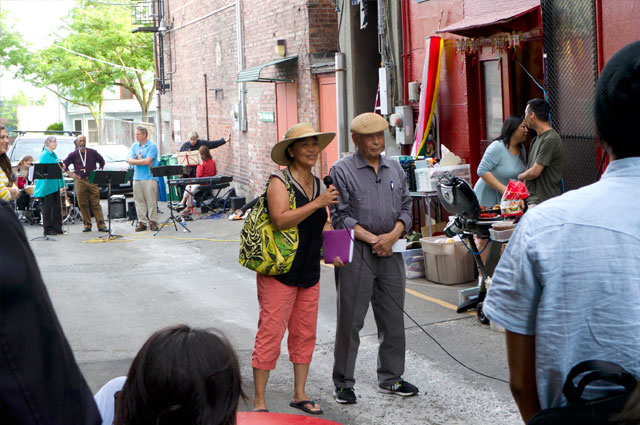
Uncle Bob Santos is introduced by SCIDpda council member Maria Batayola at Stories in the Alley
NA: Do you know how the collaboration with Uncle Bob and his book, Gang of Four, came about for Stories in the Alley?
CC: Each year, we (Chinatown Historic Alley Partnership or CHAP) work with neighborhood partners to activate the alley through programming. Wing Luke Museum also feature local musicians and bands to play in the alley. In the past, we’ve staged pop-up shops in the vacant storefronts, shaved ice in the alley, children games and activities, etc. Since we knew that Uncle Bob (Bob Santos) just published his book, Gang of Four, and has been on his book tour around the west coast, we wanted to capitalize on it and highlight him and his book at our alley party. It was a great, informal way to educate community members and visitors about the Gang of Four’s community advocacy and leadership in shaping Seattle’s communities of color today. The most valuable part (also my favorite part) was, of course, Uncle Bob’s storytelling – it was really a treat! As you may have seen, he’s quite the local celebrity, with a large fan base.
NA: Gang of Four describes how the activism of the Civil Rights Movement was leveraged by community groups and agencies to create lasting change and ongoing work on social justice issues. Does SCIDpda see itself continuing the legacy of that activism, exemplified by Uncle Bob and the other members of the Gang of Four? In what way is your work inspired or influenced by them?
CC: Uncle Bob was actually one of the founders of SCIDpda – he was on our board and later served as our executive director when SCIDpda was first established. Uncle Bob was a great role model for advocating social justice for the Chinatown International District, a historically marginalized ethnic community. Our work here at the SCIDpda, which includes property development and management (mixed-use buildings with affordable housing), senior services, and IDEA Space (a community development resource center), encompasses social justice and historic and cultural preservation in serving the needs of the people who live or work in this neighborhood. In addition to providing for affordable housing and senior services needs, SCIDpda engages community members in dialogues around changes happening within and around the neighborhood, inform and educate them about local policies and ordinances, guide them through public processes, and empower them to assume leadership roles in advocating to improve the quality of life for residents, businesses and workers in the Chinatown International District.

Neighborhood Crime Watch, a program of SCIDpda at Stories in the Alley
NA: As project manager of the Canton Alley revitalization project at SCIDpda, what has been the biggest challenge and what has been the most rewarding part of the project so far?
CC: As project manager of the Canton Alley revitalization project, the biggest challenge has been working with the City and navigating its public processes. Because the City of Seattle currently does not have any formal regulations of alleys – for the most part, they’re treated as secondary streets, City staff do not have the knowledge nor experience in alley improvement. It took plenty of time and work to establish a common goal with SDOT.
The most rewarding experience was to see neighboring property owners’ transition from skeptic to the supportive role they play in the alley revitalization effort over the course of 4 years. It makes the project so much more meaningful to have local champions and advocates who see the benefits and potential in these historic spaces.
NA: What exciting projects are coming up next for you at the Design Lab?
CC: The Design Lab does not have new projects at this point – the next year will really be carrying out and executing the projects we have on hand, including the Canton Alley repaving and lighting and signage installation, Hing Hay Park redevelopment, and facade improvement for 3 buildings. We will continue to work with local property owners and business owners to improve their facades and storefronts in the coming years.

